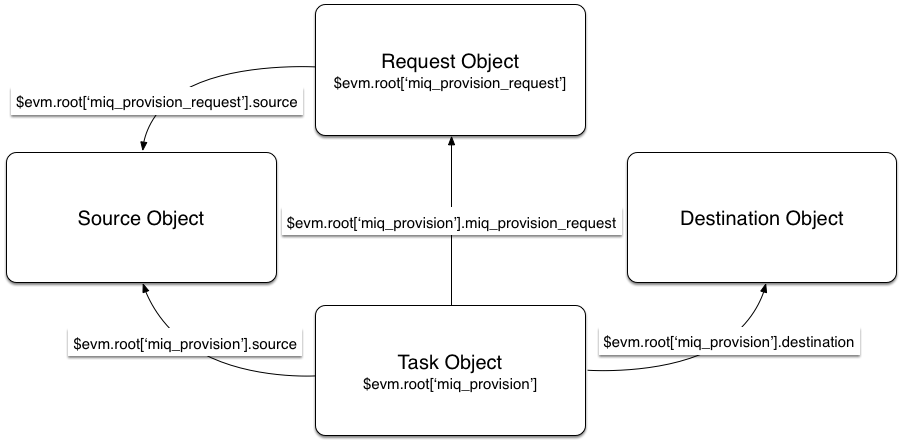VM Provisioning Objects
There are several objects involved in the VM provisioning process, however we generally only work with four of them when we program our own Automation Methods to interact with the VM Provisioning workflow.

The Request Object
We've discussed the Request Object in detail already - this is the object that contains all of the information relating to the VM Provisioning Request.
Request Context
When working at the Request stage of the provisioning process, the object is accessible directly from our workspace:
$evm.root['miq_provision_request']
There are a number of useful attributes that we can read from the Request Object, including the requester (person) details, and we can set key/value pairs in the Options Hash to control the VM provisioning process itself.
The Request Object has a number of useful methods that we can use:
miq_provision_request.add_tag
miq_provision_request.approve
miq_provision_request.authorized?
miq_provision_request.check_quota
miq_provision_request.ci_type
miq_provision_request.clear_tag
miq_provision_request.deny
miq_provision_request.description=
miq_provision_request.eligible_resources
miq_provision_request.get_classification
miq_provision_request.get_classifications
miq_provision_request.get_folder_paths
miq_provision_request.get_option
miq_provision_request.get_option_last
miq_provision_request.get_retirement_days
miq_provision_request.get_tag
miq_provision_request.get_tags
miq_provision_request.pending
miq_provision_request.register_automate_callback
miq_provision_request.set_cluster
miq_provision_request.set_customization_template
miq_provision_request.set_dvs
miq_provision_request.set_folder
miq_provision_request.set_host
miq_provision_request.set_iso_image
miq_provision_request.set_message
miq_provision_request.set_network_adapter
miq_provision_request.set_network_address_mode
miq_provision_request.set_nic_settings
miq_provision_request.set_option
miq_provision_request.set_pxe_image
miq_provision_request.set_pxe_server
miq_provision_request.set_resource
miq_provision_request.set_resource_pool
miq_provision_request.set_storage
miq_provision_request.set_vlan
miq_provision_request.set_vm_notes
miq_provision_request.set_windows_image
miq_provision_request.src_vm_id
miq_provision_request.target_type
Task Context
When working at the Task stage we have a different workspace ($evm), and here $evm.root does not link directly to miq_provision_request. We can however still get to the Request Object via an association from the Task Object:
$evm.root['miq_provision'].miq_provision_request
Note that by the time we're in the Task, setting options in the Request will have no effect, but it's still useful to be able to read values from the Request Object when in the Task stage of the VM Provisioning process.
The Task Object
The Task Object is created once the VM Provisioning Request has been approved. Most of the information in the preceding Request Object is propagated into the Task Object, most importantly the Options Hash.
The Task Object has a similar set of Methods to the Request Object:
miq_provision.add_tag
miq_provision.check_quota
miq_provision.clear_tag
miq_provision.eligible_resources
miq_provision.execute
miq_provision.finished
miq_provision.get_classification
miq_provision.get_classifications
miq_provision.get_domain_details
miq_provision.get_domain_name
miq_provision.get_folder_paths
miq_provision.get_network_details
miq_provision.get_network_scope
miq_provision.get_option
miq_provision.get_option_last
miq_provision.get_tag
miq_provision.get_tags
miq_provision.message=
miq_provision.register_automate_callback
miq_provision.set_cluster
miq_provision.set_customization_spec
miq_provision.set_customization_template
miq_provision.set_dvs
miq_provision.set_folder
miq_provision.set_host
miq_provision.set_iso_image
miq_provision.set_network_adapter
miq_provision.set_network_address_mode
miq_provision.set_nic_settings
miq_provision.set_option
miq_provision.set_pxe_image
miq_provision.set_pxe_server
miq_provision.set_resource
miq_provision.set_resource_pool
miq_provision.set_storage
miq_provision.set_vlan
miq_provision.set_vm_notes
miq_provision.set_windows_image
miq_provision.statemachine_task_status
miq_provision.target_type
miq_provision.user_message=
The most important of these is probably .execute which launches the VM provisioning job.
The Source Object
When provisioning a VM from Template, we need an object to represent the source template itself, and this is the Source Object.
The Source Object is accessible via either of two associations:
$evm.root['miq_provision_request'].source
$evm.root['miq_provision_request'].vm_template
or
$evm.root['miq_provision'].source
$evm.root['miq_provision'].vm_template
in either Request or Task context.
The Source Object contains a very useful Attribute:
source.vendor
This has the value of either "RedHat", "VMware" or "Microsoft" if we're provisioning to an Infrastructure Provider. We can use this to determine the Provider type for this provisioning operation, and make workflow decisions accordingly. This Atttribute is used in several places in the out-of-the-box VMProvision_VM State Machine to select the appropriate Instance to handle vendor-specific tasks such as VM Placement, i.e.
/Infrastructure/VM/Provisioning/Placement/default#${/#miq_provision.source.vendor}
There is also an equally useful Virtual Column:
source.platform
This has the value of either "linux" or "windows", and we can similarly use this to make provisioning workflow decisions. We might typically use this to decide whether or not to register a new VM in Foreman/Satellite 6 as part of the provisioning process, for example.
All of the Source Object classes extend from MiqAeServiceVmOrTemplate, and so have the same methods as a generic VM. In practice we rarely need to run a source method.
The Destination Object
Once the VM has been created (i.e. after the Provision State of the VMProvision_VM State Machine), we have an object that represents the newly created VM. This is the Destination Object.
The Destination Object is accessible as an association from the Task Object:
$evm.root['miq_provision'].destination
If we wish to make any customisations to the VM as part of the provisioning workflow, such as add a disk or NIC, change VLAN, etc., we make the changes to the Destination Object.
The Destination Object is a subclass of MiqAeServiceVmOrTemplate so has the standard set of VM-related methods:
destination.add_to_service
destination.changed_vm_value?
destination.collect_running_processes
destination.create_snapshot
destination.custom_get
destination.custom_keys
destination.custom_set
destination.ems_custom_get
destination.ems_custom_keys
destination.ems_custom_set
destination.ems_ref_string
destination.error_retiring?
destination.event_log_threshold?
destination.event_threshold?
destination.finish_retirement
destination.group=
destination.migrate
destination.owner=
destination.performances_maintains_value_for_duration?
destination.reboot_guest
destination.reconfigured_hardware_value?
destination.refresh
destination.registered?
destination.remove_all_snapshots
destination.remove_from_disk
destination.remove_from_service
destination.remove_from_vmdb
destination.remove_snapshot
destination.retire_now
destination.retired?
destination.retirement_state=
destination.retirement_warn=
destination.retires_on=
destination.retiring?
destination.revert_to_snapshot
destination.scan
destination.shutdown_guest
destination.snapshot_operation
destination.standby_guest
destination.start
destination.start_retirement
destination.stop
destination.suspend
destination.sync_or_async_ems_operation
destination.unlink_storage
destination.unregister
In the case of provisioning a VM, the same Destination Object is also availble via the vm association, i.e.
$evm.root['miq_provision'].vm
We often find that objects are accessible via multiple association names.